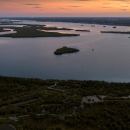Laws and Regulations
Rules, Regulations, and Permit Requirements
Presidential Proclamation 9496 established three categories of activities: prohibited (not allowed), exempted (no permit required), and regulated (may be considered through a permitting process). Specific activities mentioned in Proclamation 9496 are listed by category below.
The permitting program for regulated activities is designed to manage and minimize human impact to its unique and sensitive natural resources.
The following activities are prohibited in the Monument:
- Exploring for, developing, or producing oil and gas or minerals, or undertaking any other energy exploration or development activities within the monument.
- Using or attempting to use poisons, electrical charges, or explosives in the collection or harvest of a monument resource.
- Introducing or otherwise releasing an introduced species from within or into the monument.
- Removing, moving, taking, harvesting, possessing, injuring, disturbing, or damaging, or attempting to remove, move, take, harvest, possess, injure, disturb, or damage, any living or nonliving monument resource, except as provided under regulated activities below.
- Drilling into, anchoring, dredging, or otherwise altering the submerged lands; or constructing, placing, or abandoning any structure structure
Something temporarily or permanently constructed, built, or placed; and constructed of natural or manufactured parts including, but not limited to, a building, shed, cabin, porch, bridge, walkway, stair steps, sign, landing, platform, dock, rack, fence, telecommunication device, antennae, fish cleaning table, satellite dish/mount, or well head.
Learn more about structure , material, or other matter on the submerged lands, except for scientific instruments and constructing or maintaining submarine cables.
The following activities are exempted from the Monument's permitting program:
- Response to emergencies threatening life, property, or the environment
- Law Enforcement activities
- Activities and exercises of the Armed Forces (including the United States Coast Guard)
- Scientific exploration or research activities by or for the Secretaries
The following activities are regulated through the Monument's permitting process:
- Research and scientific exploration designed to further understanding of monument resources and qualities or knowledge of the North Atlantic Ocean ecosystem and resources.
- Activities that will further the educational value of the monument or will assist in the conservation and management of the monument.
- Anchoring scientific instruments.
- Recreational fishing in accordance with applicable fishery management plans and other applicable laws and other requirements.
- Other activities that do not impact monument resources, such as sailing or bird and marine mammal watching so long as those activities are conducted in accordance with applicable laws and regulations, including the Marine Mammal Protection Act. Nothing in the proclamation is intended to require that the Secretaries issue individual permits in order to allow such activities.
- Construction and maintenance of submarine cables.
For other U.S. Fish and Wildlife Service wildlife-related permit links that might pertain to your activity, click here.

